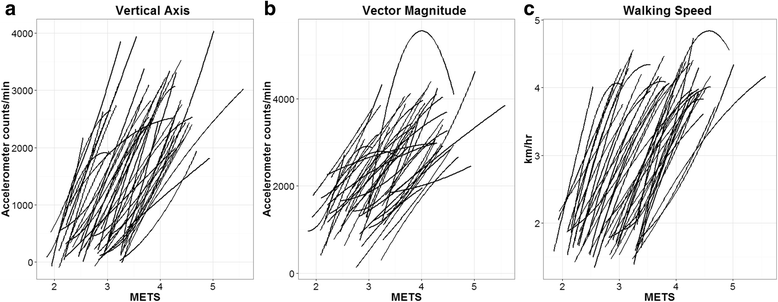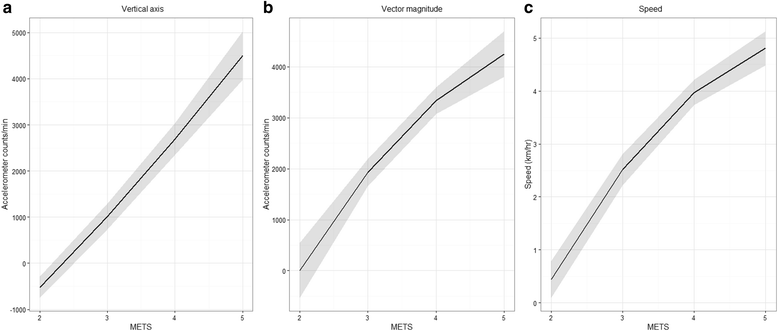Measuring moderate-intensity walking in older adults using the ActiGraph accelerometer
- PMID: 27931188
- PMCID: PMC5146877
- DOI: 10.1186/s12877-016-0380-5
Measuring moderate-intensity walking in older adults using the ActiGraph accelerometer
Abstract
Background: Accelerometry is the method of choice for objectively assessing physical activity in older adults. Many studies have used an accelerometer count cut point corresponding to 3 metabolic equivalents (METs) derived in young adults during treadmill walking and running with a resting metabolic rate (RMR) assumed at 3.5 mL · kg-1 · min-1 (corresponding to 1 MET). RMR is lower in older adults; therefore, their 3 MET level occurs at a lower absolute energy expenditure making the cut point derived from young adults inappropriate for this population. The few studies determining older adult specific moderate-to-vigorous intensity physical activity (MVPA) cut points had methodological limitations, such as not measuring RMR and using treadmill walking.
Methods: This study determined a MVPA hip-worn accelerometer cut point for older adults using measured RMR and overground walking. Following determination of RMR, 45 older adults (mean age 70.2 ± 7 years, range 60-87.6 years) undertook an outdoor, overground walking protocol with accelerometer count and energy expenditure determined at five walking speeds.
Results: Mean RMR was 2.8 ± 0.6 mL · kg-1 · min-1. The MVPA cut points (95% CI) determined using linear mixed models were: vertical axis 1013 (734, 1292) counts · min-1; vector magnitude 1924 (1657, 2192) counts · min-1; and walking speed 2.5 (2.2, 2.8) km · hr-1. High levels of inter-individual variability in cut points were found.
Conclusions: These MVPA accelerometer and speed cut points for walking, the most popular physical activity in older adults, were lower than those for younger adults. Using cut points determined in younger adults for older adult population studies is likely to underestimate time spent engaged in MVPA. In addition, prescription of walking speed based on the adult cut point is likely to result in older adults working at a higher intensity than intended.
Keywords: Energy expenditure; MET; Measurement; Physical activity; Resting metabolic rate; Vector magnitude.
Figures
Similar articles
-
Accelerometer cut-points derived during over-ground walking in persons with mild, moderate, and severe multiple sclerosis.J Neurol Sci. 2014 May 15;340(1-2):50-7. doi: 10.1016/j.jns.2014.02.024. Epub 2014 Feb 28. J Neurol Sci. 2014. PMID: 24635890
-
Individual Scaling of Accelerometry to Preferred Walking Speed in the Assessment of Physical Activity in Older Adults.J Gerontol A Biol Sci Med Sci. 2020 Sep 16;75(9):e111-e118. doi: 10.1093/gerona/glaa142. J Gerontol A Biol Sci Med Sci. 2020. PMID: 32506116
-
METs and accelerometry of walking in older adults: standard versus measured energy cost.Med Sci Sports Exerc. 2013 Mar;45(3):574-82. doi: 10.1249/MSS.0b013e318276c73c. Med Sci Sports Exerc. 2013. PMID: 23059862 Free PMC article.
-
The Physical Activity Assessment of Adults With Type 2 Diabetes Using Accelerometer-Based Cut Points: Scoping Review.Interact J Med Res. 2022 Sep 6;11(2):e34433. doi: 10.2196/34433. Interact J Med Res. 2022. PMID: 36066937 Free PMC article.
-
Re-examination of accelerometer data processing and calibration for the assessment of physical activity intensity.Scand J Med Sci Sports. 2019 Oct;29(10):1442-1452. doi: 10.1111/sms.13470. Epub 2019 Jun 2. Scand J Med Sci Sports. 2019. PMID: 31102474 Review.
Cited by
-
Assessing the Effectiveness of eHealth Interventions to Manage Multiple Lifestyle Risk Behaviors Among Older Adults: Systematic Review and Meta-Analysis.J Med Internet Res. 2024 Jul 31;26:e58174. doi: 10.2196/58174. J Med Internet Res. 2024. PMID: 39083787 Free PMC article.
-
Urban environments and objectively-assessed physical activity and sedentary time in older Belgian and Chinese community dwellers: potential pathways of influence and the moderating role of physical function.Int J Behav Nutr Phys Act. 2020 Jun 9;17(1):73. doi: 10.1186/s12966-020-00979-8. Int J Behav Nutr Phys Act. 2020. PMID: 32517790 Free PMC article.
-
Physical activity in older adults with metastatic gastrointestinal cancer: a pilot and feasibility study.BMJ Open Sport Exerc Med. 2022 May 30;8(2):e001353. doi: 10.1136/bmjsem-2022-001353. eCollection 2022. BMJ Open Sport Exerc Med. 2022. PMID: 35722047 Free PMC article.
-
Study design and methods for the using exercise to relieve joint pain and improve AI adherence in older breast cancer survivors (REJOIN) trial.J Geriatr Oncol. 2021 Sep;12(7):1146-1153. doi: 10.1016/j.jgo.2021.05.011. Epub 2021 May 26. J Geriatr Oncol. 2021. PMID: 34049837 Free PMC article. Clinical Trial.
-
Physical Activity Level Following Resistance Training in Community-Dwelling Older Adults Receiving Home Care: Results from a Cluster-Randomized Controlled Trial.Int J Environ Res Public Health. 2021 Jun 22;18(13):6682. doi: 10.3390/ijerph18136682. Int J Environ Res Public Health. 2021. PMID: 34206175 Free PMC article. Clinical Trial.
References
-
- United Nations, Department of Economic and Social Affairs, Population Division . World Population Ageing 2013. 2013.
-
- World Health Organisation. Global recommendations on physical activity for health. Geneva, Switzerland 2010. http://apps.who.int/iris/bitstream/10665/44399/1/9789241599979_eng.pdf. Accessed 24 June 2016.
MeSH terms
LinkOut - more resources
Full Text Sources
Other Literature Sources
Medical
Miscellaneous



